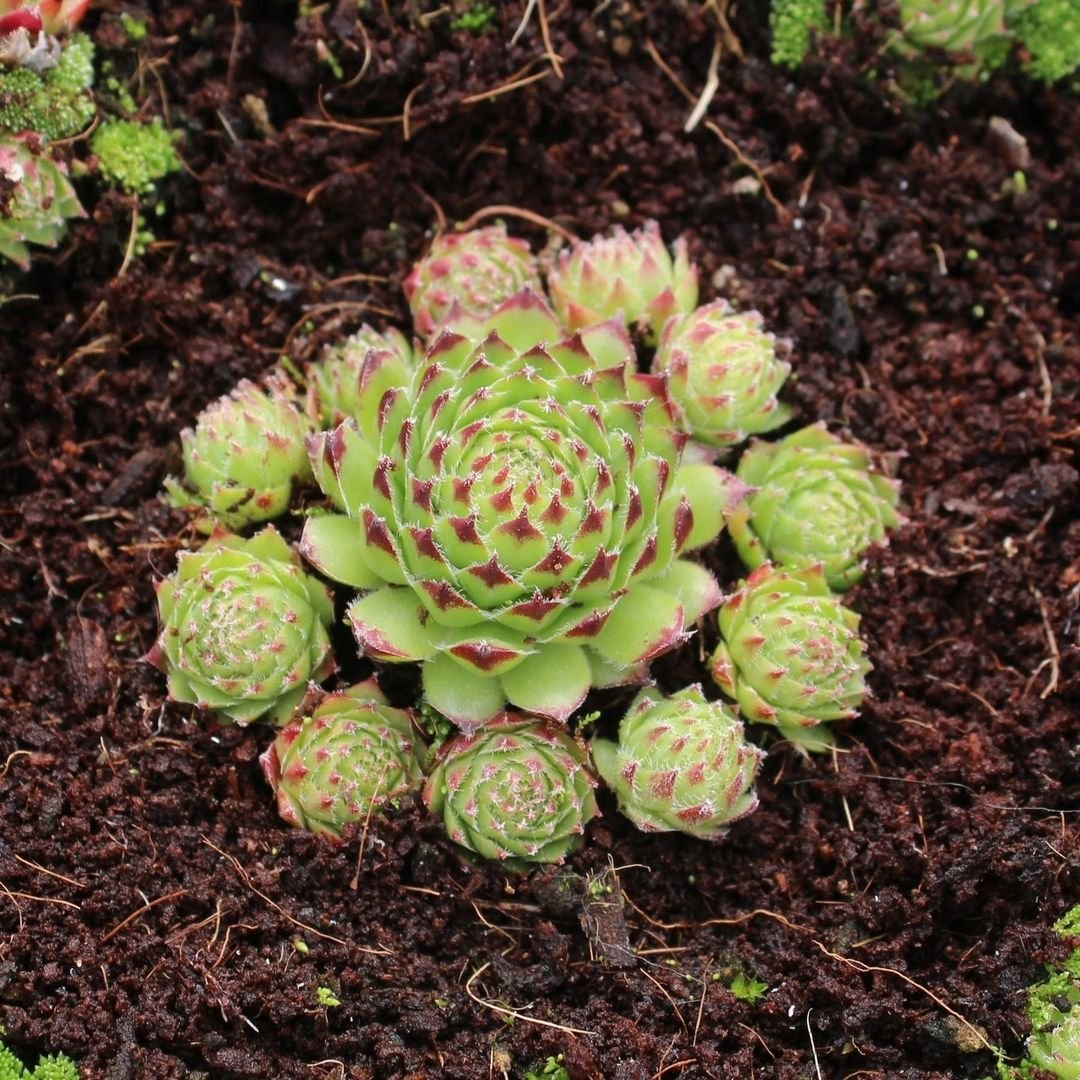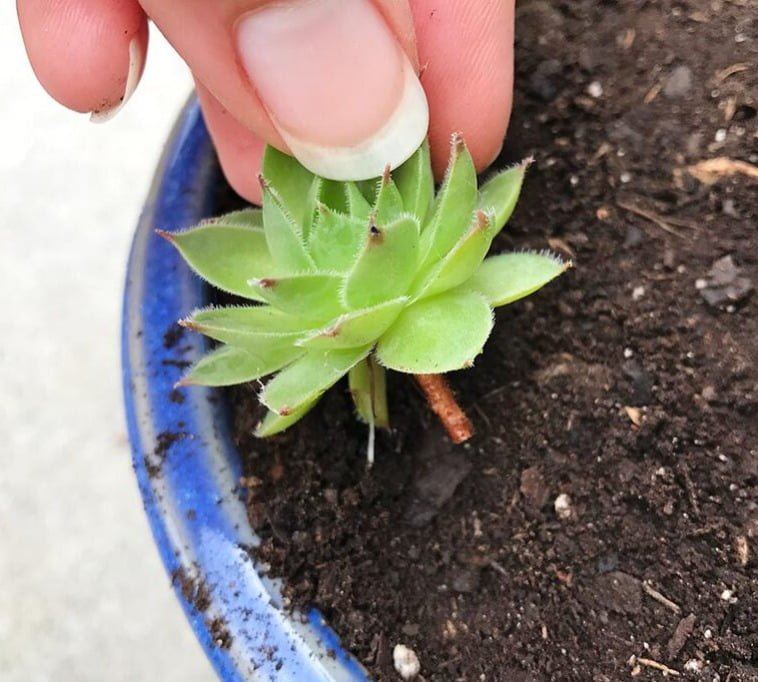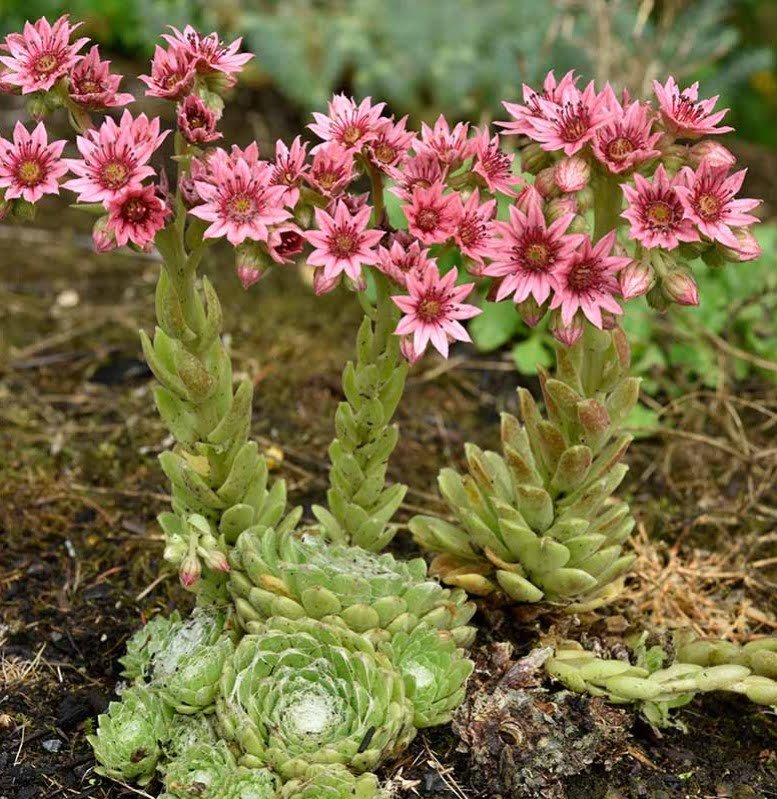Hens and chicks are a group of succulent plants that belong to the genus Sempervivum, which means “live forever” in Latin. They are also known as houseleeks, and they have been cultivated for centuries for their medicinal and ornamental value. Hens and chicks plants have fleshy, pointed leaves that form rosettes, resembling artichokes or flowers. The main rosette is called the “hen”, and it produces smaller rosettes called the “chicks” by sending out runners. These plants come in a variety of colors, shapes, and sizes, and they can create a stunning display in your garden or pots. In this article, we will show you how to grow and care for hens and chicks plants, and how to choose the best planter for them.
How to Choose a Planter for Hens and Chicks

Here’s a concise chart with information about Hens and Chicks Plant:
| Attribute | Information |
|---|---|
| Botanical Name | Sempervivum spp. |
| Plant Type | Perennial succulent |
| Soil Type | Well-draining, sandy or rocky |
| Color Varieties | Green, red, purple, brown, variegated |
| Zones | 3-8 (depends on species) |
| Exposure | Full sun to partial shade |
| Bloom Time | Summer |
| Height/Spread | 3-6 inches tall, spread up to 12 inches |
Hens and chicks plants are very adaptable and can grow in almost any type of container, as long as it has good drainage. They prefer shallow pots that allow their roots to spread out, and they can even grow in cracks and crevices of rocks, walls, or bricks. You can use clay, ceramic, metal, wood, or plastic pots, but avoid glazed or painted ones that may contain harmful chemicals. You can also use creative and unconventional planters, such as old shoes, teapots, birdhouses, or colanders to add some personality and charm to your hens and chicks display. Just make sure to drill some holes at the bottom of the planter for drainage, and fill it with a well-draining potting mix, such as cactus or succulent soil.
How to Plant Hens and Chicks in Pots

To plant hens and chicks in pots, follow these simple steps:
- Choose a healthy and vigorous hen with several chicks attached to it. You can buy them from a nursery, or get them from a friend or neighbor who has hens and chicks plants.
- Gently pull or cut off the chicks from the hen, leaving some roots attached to them. You can also leave some chicks attached to the hen if you want a fuller look.
- Fill the pot with the potting mix, leaving some space at the top for watering.
- Make some holes in the soil with your finger or a pencil, and insert the chicks into them. Press the soil around them to secure them in place. You can arrange them in any pattern or design you like, or just scatter them randomly.
- Place the hen in the center of the pot, or in any spot you prefer. Press the soil around it to secure it in place.
- Water the pot thoroughly, and let the excess water drain out. Place the pot in a sunny spot, and enjoy your hens and chicks display.
How to Plant Hens and Chicks in Gardens

To plant hens and chicks in gardens, follow these simple steps:
- Choose a sunny spot with well-drained soil. Hens and chicks plants can tolerate some shade, but they will have more color and vigor in full sun. They can also grow in poor or rocky soil, but they will appreciate some organic matter or compost mixed in.
- Dig some holes in the soil, about 6 to 12 inches apart, depending on the size of your plants. The holes should be slightly larger than the root balls of your plants.
- Remove the plants from their pots, and gently loosen the roots. Place them in the holes, and fill the gaps with soil. Press the soil around them to secure them in place.
- Water the plants thoroughly, and let the excess water drain out. Mulch around the plants with gravel, pebbles, or sand, to prevent weeds and retain moisture.
How to Care for Hens and Chicks Plants
Hens and chicks plants are very easy to care for, as they are drought-tolerant, low-maintenance, and pest-resistant. Here are some tips on how to keep them healthy and happy:
- Water them sparingly, only when the soil is dry to the touch. Overwatering can cause root rot and fungal diseases. Water them more frequently in hot and dry weather, and less in cold and wet weather. Avoid watering the rosettes directly, as this can cause them to rot or split. Water the soil around them instead.
- Fertilize them occasionally, once or twice a year, with a balanced or low-nitrogen fertilizer. Too much fertilizer can cause them to grow leggy and weak. You can also use organic fertilizers, such as compost tea, worm castings, or fish emulsion, to boost their growth and health.
- Prune them regularly, by removing any dead, damaged, or diseased leaves or rosettes. This will improve their appearance and prevent diseases from spreading. You can also remove any unwanted chicks or runners, and use them to propagate new plants.
- Protect them from extreme temperatures, especially frost and snow. Hens and chicks plants are hardy in USDA zones 3 to 11, but they may need some protection in colder climates. You can cover them with a frost cloth, straw, or mulch, or move them indoors if they are in pots. You can also choose varieties that are more cold-tolerant, such as Sempervivum arachnoideum (cobweb houseleek) or Sempervivum calcareum (lime houseleek).
- Watch out for pests and diseases, such as aphids, mealybugs, scale insects, slugs, snails, root rot, and powdery mildew. These are rare, but they can affect your plants if the conditions are not optimal. You can prevent them by providing good drainage, air circulation, and hygiene. You can also treat them with insecticidal soap, neem oil, or diatomaceous earth, or remove the infected parts and dispose of them.
How to Propagate Hens and Chicks Plants

One of the best features of hens and chicks plants is that they propagate themselves by producing chicks or offsets. You can also propagate them by seeds, but this is more time-consuming and less reliable. Here are some methods to propagate hens and chicks plants:
- By chicks: This is the easiest and fastest way to propagate hens and chicks plants. Simply pull or cut off the chicks from the hen, leaving some roots attached to them. You can do this at any time of the year, but spring and summer are the best seasons. Plant the chicks in pots or gardens, following the same steps as above. Water them well, and place them in a sunny spot. They will root and grow quickly, and produce their own chicks in a few months.
- By runners: Some hens and chicks plants produce long stems or runners, with chicks at the end. You can cut off the runners, and plant them in pots or gardens, following the same steps as above. Water them well, and place them in a sunny spot. They will root and grow quickly, and produce their own chicks in a few months.
- By seeds: This is a more challenging and unpredictable way to propagate hens and chicks plants, but it can be fun and rewarding. You can collect seeds from your own plants, or buy them from a reputable source. Sow the seeds in pots or trays, filled with a well-draining potting mix, such as cactus or succulent soil. Sprinkle the seeds lightly on the surface, and cover them with a thin layer of sand or vermiculite. Water them gently, and place them in a warm and bright spot, but not in direct sun. Keep the soil moist, but not soggy. The seeds will germinate in a few weeks, and you can transplant them to larger pots or gardens when they have several leaves. The seedlings may not look exactly like the parent plants, as they may have different colors or shapes.
How to Make Hens and Chicks Bloom

Hens and chicks plants are grown mainly for their foliage, but they can also produce flowers in summer. The flowers are usually pink, red, purple, or white, and they grow on tall stalks that rise from the center of the hen. The flowers can last for several weeks, and they can attract bees, butterflies, and hummingbirds. However, the flowering also means that the hen will die after blooming, as it has completed its life cycle. The good news is that the hen will leave behind many chicks, which will continue to grow and multiply. You can also cut off the flower stalk before it blooms, if you want to keep the hen alive.
To make hens and chicks bloom, you need to provide them with the right conditions and triggers. Here are some factors that can influence their flowering:
- Age: Hens and chicks plants usually bloom when they are 3 to 4 years old, but some varieties may take longer or shorter. You can check the age of your plants by counting the number of leaves or rings on the rosette. The more leaves or rings, the older the plant.
- Light: Hens and chicks plants need at least 6 hours of full sun per day to bloom. They may not bloom if they are in too much shade, or if they are exposed to artificial light at night. You can move them to a sunnier spot, or cover them with a dark cloth at night, to induce flowering.
- Temperature: Hens and chicks plants need a period of cold or dormancy to bloom. They may not bloom if they are in a warm or constant temperature all year round. You can expose them to some frost or snow in winter, or put them in the refrigerator for a few weeks, to simulate the natural cycle of seasons. However, do not expose them to extreme cold or heat, as this can damage or kill them.
- Water: Hens and chicks plants need less water to bloom, as they are adapted to dry conditions. They may not bloom if they are overwatered, or if they are in a humid or rainy climate. You can reduce the frequency and amount of watering, especially in winter, to stress them slightly and trigger flowering. However, do not let them dry out completely, as this can also damage or kill them.
How to Use Hens and Chicks for Medicinal Purposes
Hens and chicks plants have been used for medicinal purposes since ancient times, as they have anti-inflammatory, astringent, and wound-healing properties. They can be applied externally or internally, depending on the ailment and the preparation. Here are some ways to use hens and chicks for medicinal purposes:
- For burns, cuts, scrapes, insect bites, or skin irritations: You can use the fresh leaves or juice of hens and chicks to soothe and heal the affected area. Simply wash and crush the leaves, and apply them directly to the wound. You can also squeeze the juice from the leaves, and dab it on the wound with a cotton ball. Repeat the application several times a day, until the wound heals.
- For sore throat, cough, or bronchitis: You can use the infusion or syrup of hens and chicks to relieve the symptoms and inflammation of the respiratory tract. To make the infusion, boil a handful of fresh or dried leaves in a cup of water for 10 minutes. Strain and drink the infusion, sweetened with honey if desired. You can also add some lemon juice or ginger for extra benefits. To make the syrup, boil a handful of fresh or dried leaves in a cup of water and a cup of sugar for 20 minutes. Strain and store the syrup in a glass jar in the refrigerator. Take a teaspoon of the syrup, three times a day, or as needed.
- For diarrhea, dysentery, or stomach ulcers: You can use the decoction or tincture of hens and chicks to treat the digestive disorders and infections. To make the decoction, boil a handful of fresh or dried leaves in a quart of water for 30 minutes. Strain and drink the decoction, half a cup at a time, three times a day, or as needed. To make the tincture, soak a handful of fresh or dried leaves in a pint of vodka or brandy for two weeks. Strain and store the tincture in a dark glass bottle in a cool place. Take 10 to 20 drops of the tincture, diluted in water or juice, three times a day, or as needed.
How to Use Hens and Chicks for Ornamental Purposes
Hens and chicks plants are not only useful, but also beautiful and versatile. They can be used for ornamental purposes, both indoors and outdoors, in various ways. Here are some ideas to use hens and chicks for ornamental purposes:
- As a ground cover: You can use hens and chicks plants to cover large areas of your garden, lawn, or patio, with their colorful and textured rosettes. They can fill the gaps between rocks, stones, or bricks, or create a carpet of green, red, purple, or silver. They can also prevent soil erosion, and suppress weeds. They are ideal for rock gardens, alpine gardens, or xeriscapes, as they can tolerate drought and poor soil.
- As a border or edging: You can use hens and chicks plants to create a border or edging for your flower beds, paths, or walkways, with their neat and compact rosettes. They can contrast or complement the other plants in your garden, and add some interest and structure. They are also easy to maintain, as they do not need much pruning or trimming.
- As a container plant: You can use hens and chicks plants to decorate your pots, planters, or hanging baskets, with their varied and vibrant rosettes. They can create a stunning display on your balcony, terrace, or windowsill, and brighten up your indoor or outdoor space. They are also easy to move and rearrange, as they do not need much repotting or transplanting.
- As a craft or art project: You can use hens and chicks plants to make your own craft or art project, with their flexible and fun rosettes. You can create a wreath, a topiary, a mosaic, or a sculpture, using hens and chicks plants as the main or accent material. You can also paint, dye, or embellish them, to create your own unique and personalized design. You can also use them to make gifts, favors, or ornaments, for your friends or family.
Hens and chicks plants are amazing and versatile plants that can add color and texture to your garden or pots. They are also easy to grow and care for, as they are drought-tolerant, low-maintenance, and pest-resistant. They can also produce flowers, propagate themselves, and have medicinal and ornamental value. They are truly plants that live forever, and bring joy and beauty to your life.
Pingback: Dichondra argentea Silver Falls: A Comprehensive Guide
Pingback: Outsmarting Garden Pests: Clever Hacks to Keep Chipmunks